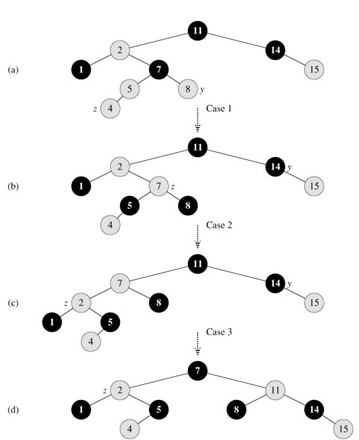SKEDSOFT
Insertion: Insertion of a node into an n-node red-black tree can be accomplished in O(lg n) time. We use a slightly modified version of the TREE-INSERT procedure to insert node z into the tree T as if it were an ordinary binary search tree, and then we color z red. To guarantee that the red-black properties are pre- served, we then call an auxiliary procedure RB-INSERT-FIXUP to recolor nodes and perform rotations. The call RB-INSERT(T, z) inserts node z, whose key field is assumed to have already been filled in, into the red-black tree T.
RB-INSERT(T, z) 1 y ← nil[T] 2 x ← root[T] 3 while x ≠ nil[T] 4 do y ← x 5 if key[z] < key[x] 6 then x ← left[x] 7 else x ← right[x] 8 p[z] ← y 9 if y = nil[T] 10 then root[T] ← z 11 else if key[z] < key[y] 12 then left[y] ← z 13 else right[y] ← z 14 left[z] ← nil[T] 15 right[z] ← nil[T] 16 color[z] ← RED 17 RB-INSERT-FIXUP(T, z)
There are four differences between the procedures TREE-INSERT and RB-INSERT. First, all instances of NIL in TREE-INSERT are replaced by nil[T]. Second, we set left[z] and right[z] to nil[T] in lines 14-15 of RB-INSERT, in order to maintain the proper tree structure. Third, we color z red in line 16. Fourth, because coloring z red may cause a violation of one of the red-black properties, we call RB-INSERT-FIXUP(T, z) in line 17 of RB-INSERT to restore the red-black properties.
RB-INSERT-FIXUP(T, z) 1 while color[p[z]] = RED 2 do if p[z] = left[p[p[z]]] 3 then y ← right[p[p[z]]] 4 if color[y] = RED 5 then color[p[z]] ← BLACK ▹ Case 1 6 color[y] ← BLACK ▹ Case 1 7 color[p[p[z]]] ← RED ▹ Case 1 8 z ← p[p[z]] ▹ Case 1 9 else if z = right[p[z]] 10 then z ← p[z] ▹ Case 2 11 LEFT-ROTATE(T, z) ▹ Case 2 12 color[p[z]] ← BLACK ▹ Case 3 13 color[p[p[z]]] ← RED ▹ Case 3 14 RIGHT-ROTATE(T, p[p[z]]) ▹ Case 3 15 else (same as then clause with "right" and "left" exchanged) 16 color[root[T]] ← BLACK
To understand how RB-INSERT-FIXUP works, we shall break our examination of the code into three major steps. First, we shall determine what violations of the red-black properties are introduced in RB-INSERT when the node z is inserted and colored red. Second, we shall examine the overall goal of the while loop in lines 1-15. Finally, we shall explore each of the three cases into which the while loop is broken and see how they accomplish the goal. Figure 13.4 shows how RB-INSERT-FIXUP operates on a sample red-black tree.

Which of the red-black properties can be violated upon the call to RB-INSERT-FIXUP? Property 1 certainly continues to hold, as does property 3, since both children of the newly inserted red node are the sentinel nil[T]. Property 5, which says that the number of black nodes is the same on every path from a given node, is satisfied as well, because node z replaces the (black) sentinel, and node z is red with sentinel children. Thus, the only properties that might be violated are property 2, which requires the root to be black, and property 4, which says that a red node cannot have a red child. Both possible violations are due to z being colored red. Property 2 is violated if z is the root, and property 4 is violated if z's parent is red. Figure 13.4(a) shows a violation of property 4 after the node z has been inserted.
The while loop in lines 1-15 maintains the following three-part invariant:
At the start of each iteration of the loop,
- Node z is red.
- If p[z] is the root, then p[z] is black.
- If there is a violation of the red-black properties, there is at most one violation, and it is of either property 2 or property 4. If there is a violation of property 2, it occurs because z is the root and is red. If there is a violation of property 4, it occurs because both z and p[z] are red.